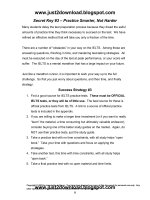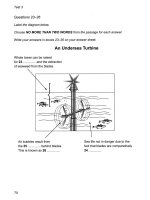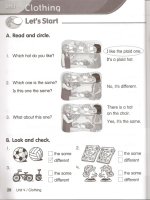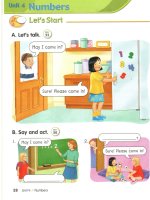Reading comprehension success part 2 potx
Bạn đang xem bản rút gọn của tài liệu. Xem và tải ngay bản đầy đủ của tài liệu tại đây (87.29 KB, 10 trang )
Making Marginal Notes
Recording your questions and reactions in the margins
turns you from a passive receiver of information into
an active participant in a dialogue. (If you’re reading a
library book, write your reactions in a notebook.) You
will get much more out of the ideas and information
you read about if you create a “conversation” with the
writer. Here are some examples of the kinds of reac-
tions you might write down in the margin or in your
notebook:
■
Questions often come up when you read. They
may be answered later in the text, but by that time,
you may have forgotten the question! And if your
question isn’t answered, you may want to discuss it
with someone: “Why does the writer describe the
new welfare policy as ‘unfair’?” or “Why does the
character react in this way?”
■
Agreements and disagreements with the author
are bound to arise if you’re actively reading. Write
them down: “That’s not necessarily true!” or “This
policy makes a lot of sense to me.”
■
Connections you note can be either between the
text and something that you read earlier or
between the text and your own experience.
For example, “I remember feeling the same way
when I . . .” or “This is similar to what happened
in China.”
■
Evaluations are your way of keeping the author
honest. If you think the author isn’t providing suf-
ficient support for what he or she is saying or that
there’s something wrong with that support, say so:
“He says the dropping of the bomb was inevitable,
but he doesn’t explain why” or “This is a very
selfish reason.”
Making Observations
Good readers know that writers use many different
strategies to express their ideas. Even if you know very
little about those strategies, you can make useful obser-
vations about what you read to better understand and
remember the author’s ideas. You can notice, for exam-
ple, the author’s choice of words; the structure of the
sentences and paragraphs; any repetition of words or
ideas; important details about people, places, and
things; and so on.
This step—making observations—is essential
because your observations (what you notice) lead you
to logical inferences about what you read. Inferences are
conclusions based on reason, fact, or evidence. You are
constantly making inferences based on your observa-
tions, even when you’re not reading. For example, if
you notice that the sky is full of dark, heavy clouds, you
might infer that it is going to rain; if you notice that
your coworker has a stack of gardening books on her
desk, you might infer that she likes gardening.
If you misunderstand what you read, it is often
because you haven’t looked closely enough at the text.
As a result, you base your inferences on your own ideas
and experiences, not on what’s actually written in the
text. You end up forcing your own ideas on the author
(rather than listening to what the author has to say) and
then forming your own ideas about it. It’s critical, then,
that you begin to really pay attention to what writers say
and how they say it.
If any of this sounds confusing now, don’t worry.
Each of these ideas will be thoroughly explained in the
lessons that follow. In the meantime, start practicing
active reading as best you can. Begin by taking the
pretest.
– HOW TO USE THIS BOOK–
xi
COMPREHENSION
SUCCESS
IN 20 MINUTES A DAY
efore you start your study of reading skills, you may want to get an idea of how much you already
know and how much you need to learn. If that’s the case, take the pretest that follows. The pretest
consists of 50 multiple-choice questions covering all the lessons in this book. Naturally, 50 ques-
tions can’t cover every single concept or strategy you will learn by working through this book. So even if you get
all the questions on the pretest right, it’s almost guaranteed that you will find a few ideas or reading tactics in this
book that you didn’t already know. On the other hand, if you get many questions wrong on this pretest, don’t
despair. This book will show you how to read more effectively, step by step.
You should use this pretest to get a general idea of how much you already know. If you get a high score, you
may be able to spend less time with this book than you originally planned. If you get a low score, you may find
that you will need more than 20 minutes a day to get through each chapter and improve your reading skills.
There’s an answer sheet you can use for filling in the correct answers on page 3. Or, if you prefer, simply cir-
cle the answer numbers in this book. If the book doesn’t belong to you, write the numbers 1–50 on a piece of paper
and record your answers there. Take as much time as you need to do this short test. When you finish, check your
answers against the answer key at the end of this lesson. Each answer offers the lesson(s) in this book that teaches
you about the reading strategy in that question.
Pretest
1
2. abcd
3. abcd
4. abcd
5. abcd
6. abcd
7. abcd
8. abcd
9. abcd
10. abcd
11. abcd
12. abcd
13. abcd
14. abcd
15. abcd
16. abcd
17. abcd
18. abcd
19. abcd
20. abcd
21. abcd
22. abcd
23. abcd
24. abcd
25. abcd
26. abcd
27. abcd
28. abcd
29. abcd
30. abcd
31. abcd
32. abcd
33. abcd
34. abcd
35. abcd
36. abcd
37. abcd
38. abcd
39. abcd
40. abcd
41. abcd
42. abcd
43. abcd
44. abcd
45. abcd
46. abcd
47. abcd
48. abcd
49. abcd
50. abcd
– LEARNINGEXPRESS ANSWER SHEET–
3
Pretest
The pretest consists of a series of reading passages with questions that follow to test your comprehension.
Cultural Center Adds Classes for Young Adults
The Allendale Cultural Center has expanded its arts program to include classes for young adults. Director Leah
Martin announced Monday that beginning in September, three new classes will be offered to the Allendale com-
munity. The course titles will be Yoga for Teenagers; Hip Hop Dance: Learning the Latest Moves; and Creative
Journaling for Teens: Discovering the Writer Within. The latter course will not be held at the Allendale Cul-
tural Center but instead will meet at the Allendale Public Library.
Staff member Tricia Cousins will teach the yoga and hip hop classes. Ms. Cousins is an accomplished cho-
reographer as well as an experienced dance educator. She has an MA in dance education from Teachers Col-
lege, Columbia University, where she wrote a thesis on the pedagogical effectiveness of dance education. The
journaling class will be taught by Betsy Milford. Ms. Milford is the head librarian at the Allendale Public Library
as well as a columnist for the professional journal Library Focus.
The courses are part of the Allendale Cultural Center’s Project Teen, which was initiated by Leah Martin,
Director of the Cultural Center. According to Martin, this project is a direct result of her efforts to make the
center a more integral part of the Allendale community. Over the last several years, the number of people who
have visited the cultural center for classes or events has steadily declined. Project Teen is primarily funded by
a munificent grant from The McGee Arts Foundation, an organization devoted to bringing arts programs to
young adults. Martin oversees the Project Teen board, which consists of five board members. Two board mem-
bers are students at Allendale’s Brookdale High School; the other three are adults with backgrounds in educa-
tion and the arts.
The creative journaling class will be cosponsored by Brookdale High School, and students who complete
the class will be given the opportunity to publish one of their journal entries in Pulse, Brookdale’s student lit-
erary magazine. Students who complete the hip hop class will be eligible to participate in the Allendale Review,
an annual concert sponsored by the cultural center that features local actors, musicians, and dancers.
All classes are scheduled to begin immediately following school dismissal, and transportation will be
available from Brookdale High School to the Allendale Cultural Center and the Allendale Public Library. For more
information about Project Teen, contact the cultural center’s programming office at 988-0099 or drop by the office
after June 1 to pick up a fall course catalog. The office is located on the third floor of the Allendale Town Hall.
– PRETEST–
5
1. The Creative Journaling for Teens class will be
cosponsored by
a. The Allendale Public Library.
b. The McGee Arts Foundation.
c. Brookdale High School.
d. Betsy Milford.
2. Which of the following statements is correct?
a. Tricia Cousins will teach two of the new
classes.
b. The new classes will begin on June 1.
c. People who want a complete fall catalogue
should stop by the Allendale Public Library.
d. The cultural center’s annual concert is called
Pulse.
3. According to Leah Martin, what was the direct
cause of Project Teen?
a. Tricia Cousins, the talented choreographer
and dance educator, was available to teach
courses in the fall.
b. Community organizations were ignoring local
teenagers.
c. The McGee Arts Foundation wanted to be
more involved in Allendale’s arts
programming.
d. She wanted to make the cultural center a more
important part of the Allendale community.
4. Which of the following factors is implied as
another reason for Project Teen?
a. The number of people who have visited the
cultural center has declined over the last
several years.
b. The cultural center wanted a grant from The
McGee Arts Foundation.
c. The young people of Allendale have com-
plained about the cultural center’s offerings.
d. Leah Martin thinks classes for teenagers are
more important than classes for adults.
5. From the context of the passage, it can be
determined that the word “munificent” most
nearly means
a. complicated.
b. generous.
c. curious.
d. unusual.
6.
The title of the course “Creative Journaling for
Teens: Discovering the Writer Within”implies that
a. all young people should write in a journal
daily.
b. teenagers do not have enough hobbies.
c. writing in a journal can help teenagers
become better and more creative writers.
d. teenagers are in need of guidance and
direction.
7. Which of the following correctly states the
primary subject of this article?
a. Leah Martin’s personal ideas about young
adults
b. The McGee Foundation’s grant to the
Allendale Cultural Center
c. three new classes for young adults added to
the cultural center’s arts program
d. the needs of young adults in Allendale
8. This article is organized in which of the
following ways?
a. in chronological order, from the past to the
future
b. most important information first, followed by
background and details.
c. background first, followed by the most impor-
tant information and details.
d. as sensational news, with the most controver-
sial topic first
– PRETEST–
6









